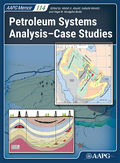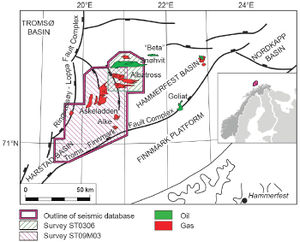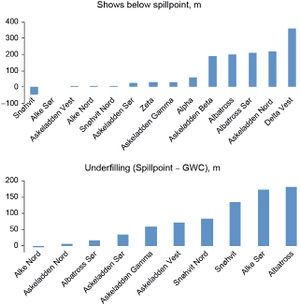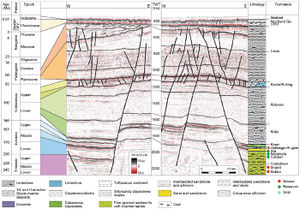Hammerfest basin
| Petroleum Systems Analysis—Case Studies | |

| |
| Series | Memoir |
|---|---|
| Chapter | Application of Overburden Amplitude Variations to Constrain Hydrocarbon Column Heights in the Hammerfest Basin, Norwegian Barents Sea |
| Author | Lidia Georgescu, Christian Hermanrud, Roar Heggland, Trine Helle Simmenes |
| Link | Web page |
| Store | AAPG Store |


Introduction[edit]
The western Hammerfest Basin is situated in the Barents Sea, north of Norway (Figure 1). It contains several gas discoveries, most (eight) of which are being produced and are collectively referred to as the Snøhvit Field. Ten of the eleven discoveries in this area were apparently not filled to their structural capacity at production start-up, and hydrocarbon shows have been noted between the gas–water contact and the depth of the structural spillpoint in all but one of the structures (Figure 2). These observations testify to leakage as a major controlling factor for the hydrocarbon column heights in the area.
While leakage has been recognized as a main contributor to the reduced column heights, there has not been a consensus on how or where the leakage actually took place. Explanations that have been put forward include overpressure-related seal failure (Sales, 1992[2]), stress release between the eastern and western parts of the study area related to the uplift (Linjordet and Grung Olsen, 1992[3]), fault reactivation (Larsen et al., 1993[4]), tilting of traps (Doré and Jensen, 1996[5]), increased seal brittleness at shallow depths (Doré, 1995[6]), and semipermeable seals and fill–spill balancing (Ohm et al., 2008[7]; Henriksen et al., 2011[8]).
Gartrell et al. (2004[9]) demonstrated by numerical modeling that stress concentrations take place at fault intersections during fault movement, and that vertical leakage is a natural response to such stress concentrations. Rotevatn et al. (2009[10]) used LIDAR imaging to demonstrate the high intensity of reservoir faults at relay ramps, and we suspect that the flexuring that resulted in such faults could also have influenced the overlying cap rocks. Field evidence of fluid transport along fault intersections is present along the Moab fault, where they are concentrated along a hard-linked (fault surfaces are joined) relay ramp (Urquhart, 2011[11]). As distinctions between hard- and soft-linked relay ramps often cannot be made from seismic data, and since significant stress variations occur at relay ramps, relay ramps should also be considered as likely positions for vertical fluid flow even if hard links cannot be confirmed in the seismic data.
Hermanrud et al. (2014[1]) investigated the position of the gas-water contact in ten discoveries and four dry structures in the western Hammerfest Basin. They demonstrated that the fluid contact of all the underfilled structures coincided with the position of intersecting faults or relay ramps at the top reservoir surface, within the uncertainty of the definition of this surface in the depth domain. They also demonstrated that the only structure that was apparently filled to its structural capacity had no intersecting faults above the fluid contacts, and that all of the four dry structures had major fault intersections updip of the well position. As a consequence, the authors suggested that vertical leakage at fault intersections or relay ramps controlled the positions of the gas-water contacts in the western Hammerfest Basin.
Several of the underfilled structures that were addressed by Hermanrud et al. (2014[1]) also have fault intersections updip of the fluid contact (see below table). The authors inferred that significant vertical leakage did not take place along these intersections. They could however not distinguish between leaky and nonleaky fault intersections, which limited the practical significance of their findings.
| Discoveries | Fault Intersections Upflank of HWC | Fault Intersections at HWC |
|---|---|---|
| Snøhvit Nord | 1 | 2 |
| Snøhvit | 2 | 1 |
| Albatross | 0 | 2 |
| Albatross Sør | 0 | 1 |
| Askeladden Sør | 1 | 1 |
| Askeladden Nord | 1 | 1+R |
| Askeladden Gamma | 3 | R |
| Askeladden Vest | 4+R | 3 |
| Alke Sør | 2 | 1 |
| Alke Nord | 0 | 0 |
| Dry Structures | Fault Intersections Upflank of Well Position | |
| Askeladden Beta | 2 | |
| Delta Vest | 1 | |
| Alpha | 2 | |
| Zeta | 2 |
Studies of seismic signatures in overburden rocks have been reported frequently in the last few years (Chand et al., 2008[12], 2009[13], 2011[14]; Perez-Garcia et al., 2009[15]; Nickel et al., 2012[16]; Ostanin et al., 2012[17], 2012[18], 2013[19]; Rajan et al., 2013[20]). Most of these studies relate main classes of observations (typically pockmarks and methane hydrates and remnants of such) to leaking gas. A common approach for all of these investigators is that they base their work on shallow observations. Ostanin et al. (2013[19]) suggested that recent periods of gas leakage, as inferred from shallow amplitude variations in overburden rocks, resulted from leakage from the underlying Snøhvit and Albatross gas discoveries. They did, however, not provide specific information on how or where they thought these structures had leaked.
Thus, while ample evidences of gas-related amplitude variations in overburden rocks have been documented, this information has not yet been fully utilized to understand leakage from hydrocarbon reservoirs. Leaking hydrocarbons may leave amplitude signatures in overburden rocks that could potentially reveal where individual traps leaked. Both seismic chimneys and bright amplitudes have previously been used for this purpose (Teige and Hermanrud, 2004[21]; Heggland, 2005[22]; Løseth et al., 2009[23]). We are however not aware of studies that have attempted to identify the position of vertical leakage for fluid contact identification in a suite of underfilled structures by combining knowledge of the structural setting, the position of the fluid contact, and overburden amplitude variations.
The purpose of the study contained in the full paper associated with this Wiki article is to document the spatial relationships between positions of vertical reservoir leakage and amplitude variations in the overburden rocks. This documentation was motivated by the hopes of obtaining (1) a further verification of the leakage model of Hermanrud et al. (2014[1]), (2) an improved understanding of the leakage processes, (3) a better understanding of how gas leakage influences amplitudes in overburden rocks, and (4) a set of guidelines that can be helpful in sealing analyses in the area. We addressed these issues by attempting to identify the fluid flow pathways that resulted in the presumably gas-related bright amplitudes in overburden rocks and by analyzing the occurrences, shapes, and intensities of seismic chimneys above and outside the positions of presumed vertical reservoir leakage.
Geological Setting[edit]
The geology of the western Barents Sea is well known (Smelror et al., 2009[24]; Henriksen et al., 2011[8], and references therein). The geological description of the study area given here is largely constrained to the elements that are significant for the understanding of leakage from structural traps of the Jurassic play. The location of the study area and the main structural elements (from Gabrielsen et al., 1984[25]) are shown in Figure 1. Ostanin et al. (2012[17]) later separated the faults in the area in four classes: first-order faults off-setting the Jurassic reservoir units and extending to the top of the Cretaceous and sometimes to the Upper Regional Unconformity (URU), second-order faults that offset reservoir rocks but do not extend to the top Cretaceous, the polygonal faults, and the Paleocene to Eocene faults that do not connect to the deeper faults.
The western Hammerfest Basin was formed as a response to a Late Jurassic to Early Cretaceous rifting episode with a largely east–west extension in the western part of the study area. This rifting had an oblique stress component that resulted in local north–south extension in the eastern part of the basin (Berglund et al., 1986[26]; Faleide et al., 2008[27]). A Late Cretaceous–Early Tertiary megashear system developed along the margins of the Norwegian–Greenland Sea, which resulted in local transpression and transtension along restraining and releasing bends of this shear system. Some of the Jurassic to Early Cretaceous normal faults were rejuvenated at this time period in the Hammerfest Basin (Gabrielsen, 1984[28]; Berglund et al., 1986[26]).

The litho- and chronostratigraphy of the Mesozoic and Cenozoic sequences of the Hammerfest Basin, as well as the main tectonic events and main components of the petroleum system in the area, are shown in Figure 3. The main reservoir rocks in the area, and the only ones considered in this study, are the Early Jurassic sandstones deposited in coastal plain (Nordmela Formation) and shallow marine (Stø Formation) environments. These rocks were overlain by the organic poor shales of the Fuglen Formation, which separates the Jurassic reservoirs from the main source rock in the area (Late Jurassic Hekkingen Formation). The Lower Cretaceous rocks mainly consist of shales of the Knurr and Kolje formations and are overlain by the Kolmule Formation, which has a somewhat higher silt content (Mørk et al., 1999[29]). This formation is again overlain by a Cenomanian to Campanian rock sequence, which consists of condensed calcareous units of the Kviting Formation in the central Hammerfest Basin and of claystones of the Kveite Formation elsewhere in the study area. The Kveite, Kviting, and upper part of the Kolmule formations are intersected by polygonal faults in parts of the study area, which may have served as fluid flow pathways and connected gas from underlying reservoir to the Paleocene strata of the Torsk Formation (Ostanin et al., 2012[17]). The Paleocene to Eocene transition is characterized by an angular unconformity, on top of which clinoforms reflect prograding sediments with shaly and some coarser material intermixed (Knutsen and Vorren, 1991[30]). The overburden rocks thus mainly consist of shales but with occasional coarser (permeable) layers in distinct sequences. About 1 km (0.6 mi) of Cenozoic rocks have been removed from the Hammerfest Basin (Nyland et al., 1992[31]) after maximum burial in Oligocene to Miocene times (Doré and Jensen, 1996[5]). The amount of erosion increases eastward, with differing suggestions of the timing and amount of individual erosional episodes (Cavanagh et al., 2006[32]). The top of the eroded rocks, termed the URU, also marks the base of the 100–300-m (328–984-ft)-thick Quaternary glaciogenic sediments. The water depth in the area is about 300 m (984 ft).
The hydrocarbons were largely sourced from the deep Cretaceous Tromsø Basin to the west, although minor contributions from locally mature source rocks above the deeper structures may also have occurred. The trap filling mainly occurred from Middle Cretaceous times to the time of maximum burial. The leakage that resulted in the present underfilling of traps occurred after this time. Gas exsolution from oil and pore water and gas expansion due to fluid pressure decrease during erosion also resulted in increased gas volumes in the traps and contributed to overpressure generation here (Hermanrud et al., 2013[33]). Hermanrud et al. (2014[1]) used the observation that the gas-water contacts coincide with the depth of the top reservoir surface at fault intersections or relay ramps as a main argument for these positions as being leakage locations. This suggestion implies that the leakage took place late in the erosional history or after it.
See also[edit]
References[edit]
- ↑ 1.0 1.1 1.2 1.3 1.4 Hermanrud, C., M. E. Hakjelsvik, K. Kristiansen, A. Bernal, and A. C. Strömbäck, 2014, Column height controls in the western Hammerfest Basin: Petroleum Geoscience, v. 20, p. 227–240.
- ↑ Sales, J. K., 1992, Uplift and subsidence of northwestern Europe: Possible causes and influence on hydrocarbon prospectivity: Norsk Geologisk Tidsskrift, v. 72, no. 3, p. 253–258.
- ↑ Linjordet, A., and R. Grung Olsen, 1992, The Jurassic Snøhvit Gas Field, Hammerfest Basin, Offshore Northern Norway, in Michel T. Halbouty, ed., Giant oil and gas fields of the decade 1978-1988: AAPG Memoir 54, p. 349–370.
- ↑ Larsen, R. M., T. Fjéran, and O. Skarpnes, 1993, Hydrocarbon potential of the Norwegian Barents Sea based on recent well results, in T. O. Vorren, E. Bergsager, Ø. A. Dahl- Stamnes, E. Holter, B. Johansen, E. Lie, et al., eds., Arctic geology and petroleum potential: Norwegian Petroleum Society (NPF) Special publication 2, Elsevier, Amsterdam, p. 321–331.
- ↑ 5.0 5.1 Doré, A. G., and L. N. Jensen, 1996, The impact of late Cenozoic uplift and erosion on hydrocarbon exploration: Offshore Norway and some other uplifted basins: Global and Planetary Change, v. 12, p. 415–436.
- ↑ Doré, A. G. 1995, Barents Sea geology, petroleum resources and commercial potential: Arctic, v. 48, p. 207–221.
- ↑ Ohm, S. E., D. A. Karlsen, and T. J. F. Austin, 2008, Geochemically driven exploration models in uplifted areas: Examples from the Norwegian Barents Sea: AAPG Bulletin, v. 92, no. 9, p. 1191–1223.
- ↑ 8.0 8.1 Henriksen, E., A. E. Ryseth, G. B. Larssen, T. Heide, K. Rønning, K. Sollid, et al., 2011, Tectonostratigraphy of the greater Barents Sea: Implications for petroleum systems, in A. M. Spencer, A. F. Embry, D. L. Gautier, A. V. Stoupakova, and K. Sørensen, eds., Arctic petroleum geology: Geological Society (London) Memoir 35, p. 163–195.
- ↑ Gartrell, A., Y. Zhang, M. Lisk, and D. Dewhurst, 2004, Fault intersections as critical hydrocarbon leakage zones: Integrated field study and numerical modeling of an example from the Timor Sea, Australia: Marine and Petroleum Geology, v. 21, p. 1165–1179.
- ↑ Rotevatn, A., S. J. Buckley, J. A. Howell, and H. Fossen, 2009, Overlapping faults and their effect on fluid flow in different reservoir types: A LIDAR-based outcrop modeling and flow simulation study: AAPG Bulletin, v. 95, p. 407–427.
- ↑ Urquhart, A. S. M., 2011, Structural controls on CO2 leakage and diagenesis in a natural long-term carbon sequestration analogue: Little grand wash fault, Utah: M. S. thesis, University of Texas, Austin, TX.
- ↑ Chand, S., J. Mienert, K. Andreassen, J. Knies, L. Plassen, B. Fotland, 2008, Gas hydrate stability zone modelling in areas of salt tectonics and pockmarks of the Barents Sea suggests an active hydrocarbon venting system: Marine and Petroleum Geology, v. 25, p. 625–636.
- ↑ Chand, S., L. Rise, D. Ottesen, M. F. J. Dolan, V. Bellec, and R. Bøe, 2009, Pockmark-like depressions near the Goliat hydrocarbon field, Barents Sea: Morphology and genesis: Marine and Petroleum Geology, v. 26, p. 1035–1042.
- ↑ Chand, S., L. Rise, J. Knies, H. Haflidason, B. O. Hjelstuen, and R. Bøe, 2011, Stratigraphic development of the south Vøring margin (Mid-Norway) since early Cenozoic time and its influence on subsurface fluid flow: Marine and Petroleum Geology, v. 28, p. 1350–1363.
- ↑ Perez-Garcia, C., T. Feseker, J. Mienert, and C. Berndt, 2009, The Håkon Mosby mud volcano: 330 000 years of focused fluid flow activity at the SW Barents Sea slope: Marine Geology, v. 262, p. 105–115.
- ↑ Nickel, J. C., R. di Primio, K. Mangelsdorf, D. Stoddard, and J. Kallmeyer, 2012, Characterization of microbial activity in pockmark fields of the NW Barents Sea: Marine Geology, v. 332-334, p. 152–162.
- ↑ 17.0 17.1 17.2 Ostanin, I., Z. Anka, R. di Primio, and A. Bernal, 2012a, Identification of a large Upper Cretaceous polygonal fault network in the Hammerfest basin: Implications on the reactivation of regional faulting and gas leakage dynamics, SW Barents Sea: Marine Geology, v. 332–334, p. 109–125.
- ↑ Ostanin, I., Z. Anka, R. di Primio, and A. Bernal, 2012b, Hydrocarbon leakage above the Snøhvit gas field, Hammerfest Basin SW Barents Sea: First Break, v. 20, p. 55–60.
- ↑ 19.0 19.1 19.2 Ostanin, I., Z. Anka, R. di Primio, and A. Bernal, 2013, Hydrocarbon plumbing systems above the Snøhvit gas field: Structural control and implications for thermogenic methane leakage in the Hammerfest Basin, SW Barents Sea: Marine and Petroleum Geology, v. 43, p. 127–146.
- ↑ Rajan, A., S. Büntz, J. Mienert, A. J. Schmidt, 2013, Gas hydrate systems in petroleum provinces of the SW Barents Sea: Marine and Petroleum Geology, v. 46, p. 92–106.
- ↑ Teige, G. M. G., and C. Hermanrud, 2004, Seismic characteristics of fluid leakage from an underfilled and overpressured Jurassic fault trap in the Norwegian North Sea: Petroleum Geoscience, v. 10, no. 1, p. 35–42.
- ↑ Heggland, R., 2005, Using gas chimneys in seal integrity analysis: A discussion based on case histories, in P. Boult and J. Kaldi, eds., Evaluating fault and cap rock seals: AAPG Hedberg Series 2, p. 237–245.
- ↑ Løseth, H., M. Gading, and L. Wensaas, 2009, Hydrocarbon leakage interpreted on seismic data: Marine and Petroleum Geology, v. 26, p. 1304–1319.
- ↑ Smelror, M., O. V. Petrov, G. B. Larsen, and S. Werner, eds., 2009, Atlas—Geological history of the Barents Sea: Geological Survey of Norway, Trondheim, 135 p.
- ↑ Gabrielsen, R. H., R. B. Faerseth, G. Hamar, and H. C. Rønnevik, 1984, Nomenclature of the main structural features on the Norwegian Continental Shelf north of 62nd parallel, in A. M. Spencer, S. O. Johnsen, A. Mørk, E. Nyséther, P. Songstad and Å. Spinnangr, Petroleum geology of the North European margin: Norwegian Petroleum Society, Graham & Trotman, London, p. 40–60.
- ↑ 26.0 26.1 Berglund, L. T., J. Augustson, R. Férseth, I. Gjelberg, and H. Ramberg-Moe, 1986, The evolution of the Hammerfest Basin, in A. M. Spencer, E. Holter, C. J. Cambell, S. H. Hanslien, P. H. H. Nelson, E. Nyséther, et al., eds., Habitat of hydrocarbons on the Norwegian continental shelf: Norwegian Petroleum Society (NPF): London, Graham & Trotman, p. 319–338.
- ↑ Faleide, J. I., F. Tsikalas, A. J. Breivik, R. Mjelde, O. Ritzman, Ø. Engen, et al., 2008, Structure and evolution of the continental margin off Norway and the Barents Sea: Episodes, v. 31, no. 1, p. 82–91.
- ↑ Gabrielsen, R. H., 1984, Long-lived fault zones and their influence on the tectonic development of the southwestern Barents Sea: Journal of the Geological Society of London, v. 141, p. 651–662.
- ↑ Mørk, A., W. K. Dallmann, H. Dypvik, E. P. Johannesen, G. B. Larsen, J. Nagy, et al., 1999, Mesozoic lithostratigraphy, in W. K. Dallmann, ed., Lithostratigraphic lexicon of Svalbard: Review and Recommendations for Nomenclature Use. Upper Paleozoic to Quaternary Bedrock, Norsk Polarinstitutt, Tromsø, p. 127–214.
- ↑ Knutsen, S. M., and T. O. Vorren, 1991, Early Cenozoic sedimentation in the Hammerfest Basin: Marine Geology, v. 101, no. 1–4, p. 31–48.
- ↑ Nyland, B., L. N. Jensen, J. Skagen, O. Skarpnes, and T. Vorren, 1992, Tertiary uplift and erosion in the Barents Sea: Magnitude, timing and consequences, in R. M. Larsen, H. Brekke, B. T. Larsen, and E. Talleraas, eds., Structural and tectonic modelling and its application to petroleum geology: Norwegian Petroleum Society Special Publications 1, p. 153–162.
- ↑ Cavanagh, A. J., R. Di Primio, M. Schenck-Wenderoth, and B. Horsfield, 2006, Severity and timing of Cenozoic exhumation in the southwestern Barents Sea: Journal of the Geological Society of London, v. 163, p. 761–774.
- ↑ Hermanrud, C., J. M. Venstad, J. Cartwright, L. Rennan, K. Hermanrud, and H. M. Nordgård Bolås, 2013b, Consequences of water level drops for soft sediment deformation and vertical fluid leakage: Mathematical Geosciences, v. 45, no. 1, p. 1–30.